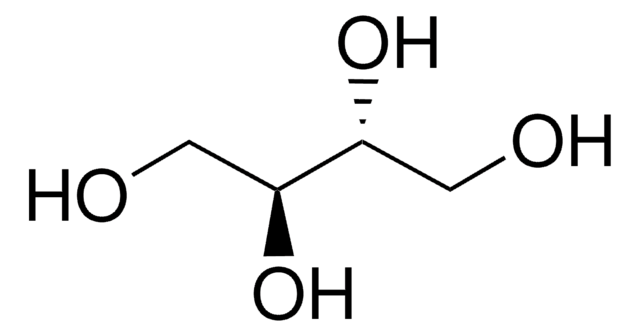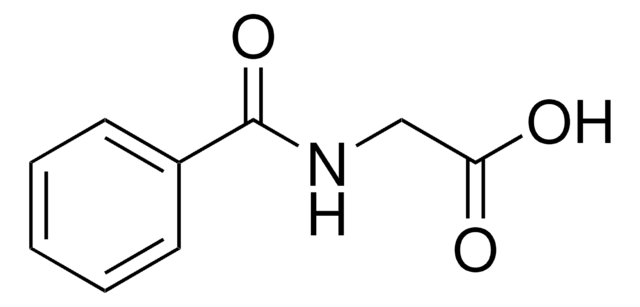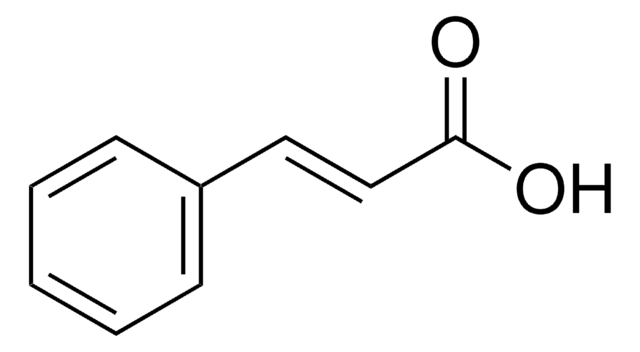D0256
Dulcitol
≥99% (GC)
Synonym(s):
Dulcite, Galactitol
Sign Into View Organizational & Contract Pricing
All Photos(2)
About This Item
Empirical Formula (Hill Notation):
C6H14O6
CAS Number:
Molecular Weight:
182.17
Beilstein/REAXYS Number:
1721903
EC Number:
MDL number:
UNSPSC Code:
12352201
PubChem Substance ID:
NACRES:
NA.25
Recommended Products
Quality Level
assay
≥99% (GC)
form
crystals
sweetness
<0.6 × sucrose
color
white
solubility
water: 50 mg/mL, clear, colorless
SMILES string
OC[C@@H](O)[C@H](O)[C@H](O)[C@@H](O)CO
InChI
1S/C6H14O6/c7-1-3(9)5(11)6(12)4(10)2-8/h3-12H,1-2H2/t3-,4+,5+,6-
InChI key
FBPFZTCFMRRESA-GUCUJZIJSA-N
Looking for similar products? Visit Product Comparison Guide
Application
Dulcitol (Galactitol), a sugar alcohol derived through reduction of galactose, is important in studies related to cataract formation, hepatosplenomegaly and mental retardation. It is used as a substrate to identify, differentiate and characterize galactitol dehydrogenase(s). Galactitol may be used as a reference compound in analytical procedures developed to analyze sugar alcohols in plants and food.
Biochem/physiol Actions
A sugar alcohol and slightly sweet tastant for human taste cells.
Other Notes
To gain a comprehensive understanding of our extensive range of Sugar alcohols for your research, we encourage you to visit our Carbohydrates Category page.
Storage Class
11 - Combustible Solids
wgk_germany
WGK 3
flash_point_f
Not applicable
flash_point_c
Not applicable
ppe
Eyeshields, Gloves, type N95 (US)
Choose from one of the most recent versions:
Already Own This Product?
Find documentation for the products that you have recently purchased in the Document Library.
Customers Also Viewed
H P Schwarz et al.
Clinical chemistry, 31(3), 420-422 (1985-03-01)
An oral dose of galactose, 1 g/kg of body weight, was administered to 24 children with the Duarte variant/classical galactosemia genetic compound (GtD/gt) and to 16 controls ranging in age from 0.3 to 10.7 years. Urine was then collected for
Joanne Hughes et al.
The Journal of pediatrics, 154(5), 721-726 (2009-02-03)
To determine the long-term outcome of dietary intervention in siblings from 14 Irish families with classical galactosemia (McKusick 230400), an autosomal recessive disorder of carbohydrate metabolism and galactose-1-phosphate uridyltransferase (GALT) deficiency. Outcomes in siblings on dietary galactose restriction were studied
C Jakobs et al.
Pediatric research, 18(8), 714-718 (1984-08-01)
A stable isotope dilution assay for galactitol in amniotic fluid has been developed using selected ion monitoring chemical ionization gas chromatography-mass spectrometry of the hexaacetate derivative. [1,1-2H2]Galactitol was synthesized for use as the internal standard. Galactitol is a component of
Peter F Kador et al.
Journal of ocular pharmacology and therapeutics : the official journal of the Association for Ocular Pharmacology and Therapeutics, 25(4), 299-308 (2009-05-20)
The two most widely investigated animal models for diabetic retinopathy (DR) are the rat and dog. In dogs, aldose reductase (AR) is present only in retinal capillary pericytes and their destruction has been linked to polyol accumulation and resulting apoptosis.
Ignasi Barba et al.
Investigative ophthalmology & visual science, 51(9), 4416-4421 (2010-04-09)
To explore the metabolic profile of vitreous fluid of patients with proliferative diabetic retinopathy (PDR) using 1H-NMR-based metabonomic analysis. 1H-NMR spectra were acquired from vitreous samples obtained during vitrectomy from 22 patients with type 1 diabetes with PDR and from
Our team of scientists has experience in all areas of research including Life Science, Material Science, Chemical Synthesis, Chromatography, Analytical and many others.
Contact Technical Service











